-
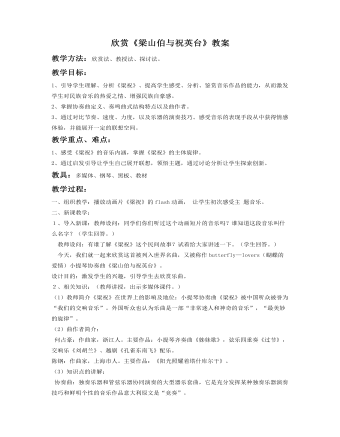
欣赏《梁山伯与祝英台》教案
教学过程:一、组织教学:播放动画片《梁祝》的flash动画, 让学生初次感受主 题音乐。二、新课教学:1、导入新课:教师设问:同学们你们听过这个动画短片的音乐吗?谁知道这段音乐叫什么名字?(学生回答。) 教师设问:有谁了解《梁祝》这个民间故事?试着给大家讲述一下。(学生回答。) 今天,我们就一起来欣赏这首被列入世界名曲,又被称作butterfly—lovers(蝴蝶的爱情)小提琴协奏曲《梁山伯与祝英台》。设计目的:激发学生的兴趣,引导学生去欣赏乐曲。2、相关知识:(教师讲授,出示多媒体课件。)(1)教师简介《梁祝》在世界上的影响及地位:小提琴协奏曲《梁祝》被中国听众被誉为“我们的交响音乐”。外国听众也认为乐曲是一部“非常迷人和神奇的音乐”,“最美妙的旋律”。(2)曲作者简介: 何占豪:作曲家,浙江人。主要作品:小提琴齐奏曲《姊妹歌》,弦乐四重奏《过节》,交响乐《刘胡兰》、越剧《孔雀东南飞》配乐。陈钢:作曲家,上海市人。主要作品:《阳光照耀着塔什库尔干》。(3)知识点的讲解: 协奏曲:独奏乐器和管弦乐器协同演奏的大型器乐套曲,它是充分发挥某种独奏乐器演奏技巧和鲜明个性的音乐作品意大利原文是“竞奏”。3、下面,欣赏《梁祝》的主要部分音乐。
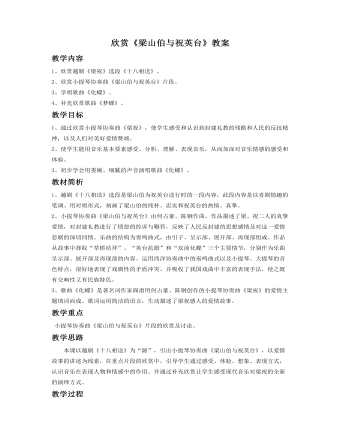
欣赏《梁山伯与祝英台》教案
教学过程第一环节:恋蝶——欣赏越剧《十八相送》感受越剧韵味,了解越剧。 1、提问导入特点,并为欣赏下一作品做好铺垫。(1)越剧是浙江地方戏剧剧种之一,你能说出一些著名的越剧代表作品吗?(2)导出越剧《梁祝》并请学生说说梁祝故事。(3)教师小结。(4)欣赏越剧《十八相送》。(5)简单介绍越剧特点(唱腔、语言)。第二环节:颂碟——欣赏小提琴协奏曲《梁祝》片断。1、导入:介绍作品地相关知识。(1)教师:这个千古传颂的爱情故事可以用越剧的形式来表现。那么,我们是否可以用其他形式来表现呢?我们中国就有两位作曲家何占豪和陈刚,他们为了探索交响音乐的民族化,选择了这一家喻户晓的民间传说为题材,吸取越剧中的曲调为素材,运用西洋手法,成功地创作了一部小提琴协奏曲《梁祝》。(2)介绍乐器小提琴、大提琴(出示图片)。 2、欣赏“爱情主题”(1)请学生聆听爱情主题音乐根据提问,让学生思考:①这段主旋律由哪样乐器演奏? ②这段主旋律有什么特点?自主参与讨论分析作品。(2)学生思考并回答。(3)教师总结: 旋律优美动听、委婉曲折,带有越剧韵味。节奏舒缓,情绪明朗。表现出爱情的美好。3、介绍协奏曲 协奏曲是指一种由独奏乐器与管弦乐队协同演奏的大型器乐作品。在音乐 进行中,独奏乐器与乐队常常轮流出现,独奏时乐队处于伴奏地位。全奏时,独奏乐器休止,完全由乐队演奏。
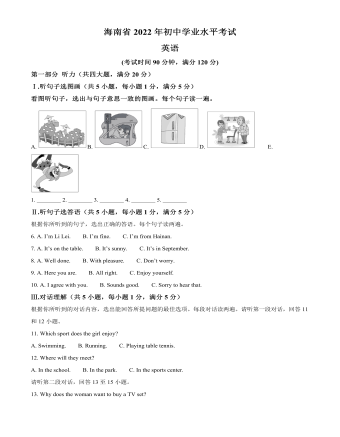
2022年海南省中考英语真题(解析版)
In the late autumn, John was badly ill andbecame bedridden (长期卧床的).After the doctor visited John several times, he told Sue, “His condition isquite ___22___.John seems to have lost all will to live. If he doesn’t want to live, medicineswill not help him.”
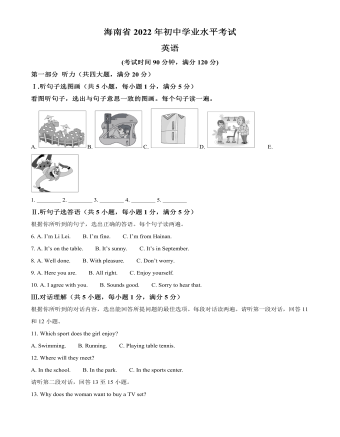
2022年海南省中考英语真题(原卷版)
YangHongwei, 56, was born into a kite-making family in Weifang. When she was young,she often saw kites with bright colors and different shapes in hergrandfather’s workshop.

2022年河南省中考英语真题(原卷版)
In the large yard stood thirteen trees ofdifferent sizes. One day, while Joey was playing with his sister under thetrees, he noticed that a tree trunk (树干) had a sad look. He raninto the house to tell his mom about it. She told Joey to find the reason whyit was sad.
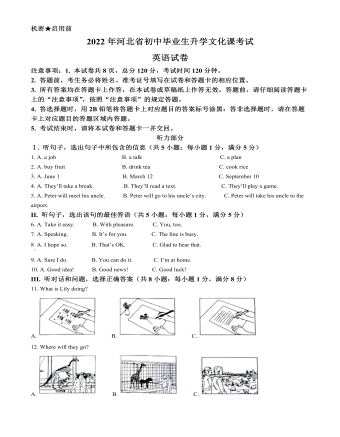
2022年河北省中考英语真题(原卷版)
As a boy, Kevin visited national parks and helearned the Earth is in ___12___ condition. He felt worried, and hewanted to ___13___ the Earth. In 2009, he went to swim in water nearNorth Pole(北极)todraw people’s attention to the melting glaciers(融化的冰川).
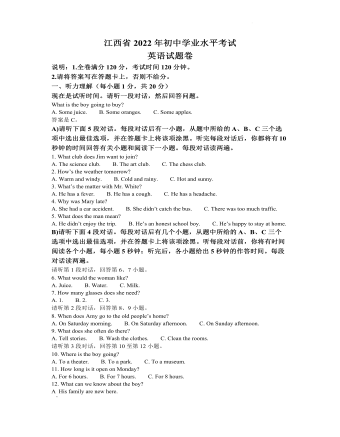
2022年江西省中考英语真题(原卷版)
Long ago, a poor old couple lived on the coast.One day, an old storyteller came to their village. The old couple gave him ameal. In return, he gave them a coffee mill (磨粉机)and said, “Say, ‘Mill, please grind (磨粉)’,”
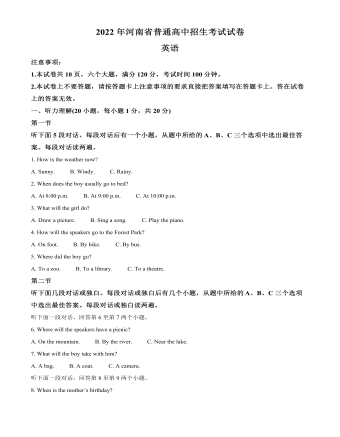
2022年河南省中考英语真题(解析版)
In the large yard stood thirteen trees ofdifferent sizes. One day, while Joey was playing with his sister under thetrees, he noticed that a tree trunk (树干) had a sad look. He raninto the house to tell his mom about it. She told Joey to find the reason whyit was sad.
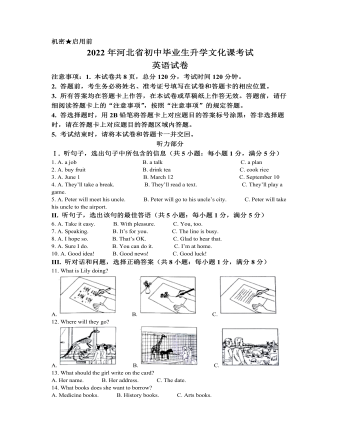
2022年河北省中考英语真题(解析版)
As a boy, Kevin visited national parks and helearned the Earth is in ___12___condition. He felt worried, and he wanted to ___13___ the Earth. In 2009, he went to swim in waternear North Pole(北极)todraw people’s attention to the melting glaciers(融化的冰川).
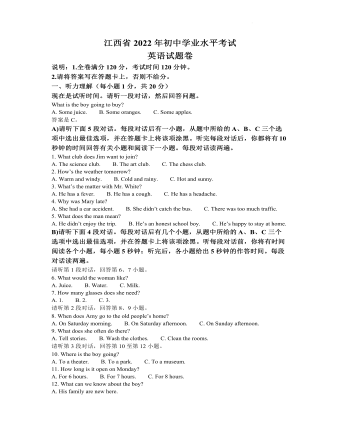
2022年江西省中考英语真题(解析版)
The app — called Sit With Us — is ___15___. If a student is having lunch in the afternoon,he or she can create an invitation. Other students can open the app and ___16___ that invitation. They can then use the app todecide when and where to ___17___.
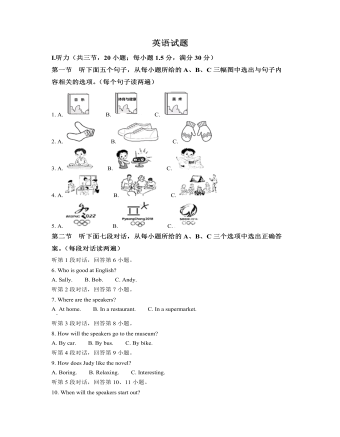
2022年福建省中考英语真题(原卷版)
Thinking that her dream could never come true,Kelly was in low spirits and ____18____ her studies at school. Hermother did all she could to cheer her up, ____19____ Kelly refused tochange. She even took out all her anger and ____20____ on her mother.
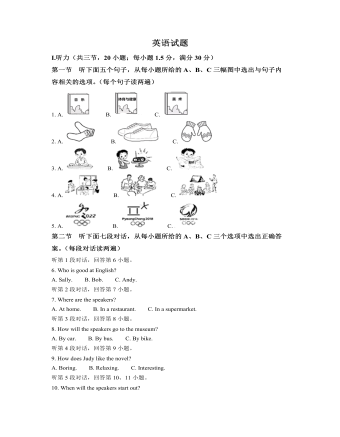
2022年福建省中考英语真题(解析版)
At the age of nine, Kelly dreamed of being abasketball player. But one day when she was playing basketball, she hurt herleft leg ____16____.
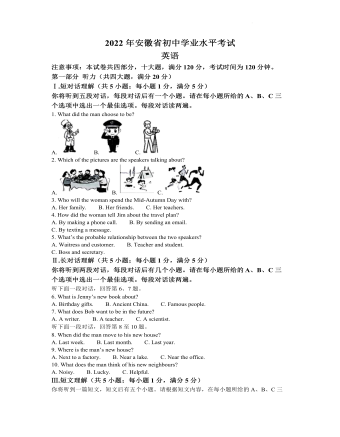
2022年安徽省中考英语真题(解析版)
Antarctica lies in the most southern part of theworld. It is the coldest area on Earth. There isn’t much rain, but there is alot of snow and wind. The lowest temperature was on 21 July in 1983 at -89.2℃!
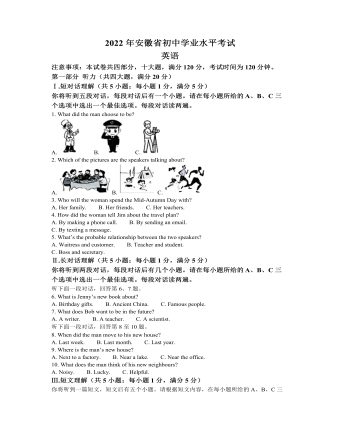
2022年安徽省中考英语真题(原卷版)
During 1907-1909, British explorer EarnestShackleton explored Antarctica on foot. In 1911, two explorers—a British mannamed Scott and a Norwegian named Amundsen—raced 1, 400 kilometres to the SouthPole (南极).Amundsen arrived first.
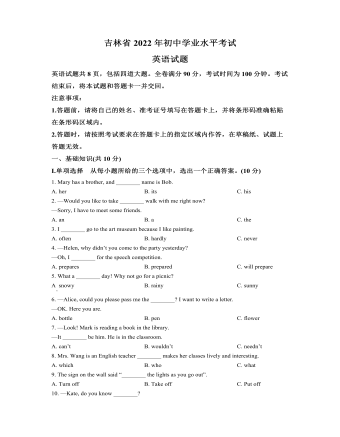
2022年吉林省中考英语真题(原卷版)
Taiping nijiaojiao is made of the mudfrom the local mountain. It takes more than ten steps to make the clay toy, andthe key step is to knead (捏) it with your hands. You can knead the clay toyinto anything, like animals and plants. The blowhole is the most difficult partto make, for the size of the blowhole makes a difference to the sound. Whilecoloring, you can use traditional cultural elements (元素) thatcarry good meanings. It’s hard to make taipingnijiaojiao. But when you finally make it, you will feel proud of yourself.
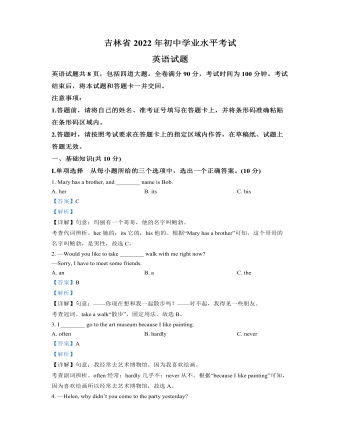
2022年吉林省中考英语真题(解析版)
“Red Trip” in TonghuaTonghua is a good choice to have a “red trip”. It is aplace full of “red stories”. The well-known national hero Yang Jingyu oncefought here. Experience the “red spirit”!
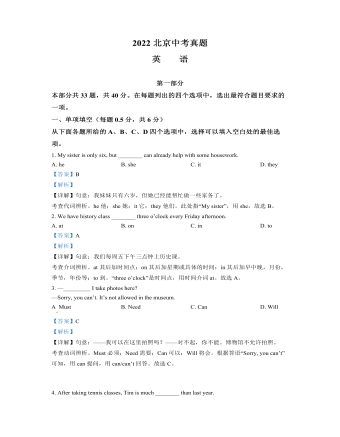
2022年北京市中考英语真题(解析版)
I joineda band (乐队)as a drummer in my middle school. I thought itwould be fun playing the drum and meeting new friends. At first it was easy,but a month later, it got difficult. I was the only one who couldn’t keep pace (节奏)with the other players. Our teacher,Angie, singled me out to keep practicing while everyone else got to relax. Ifelt ashamed (羞愧的)as my teammates watched me fail so many times.Finally I got so tired of practicing that I didn’t care about doing it right.
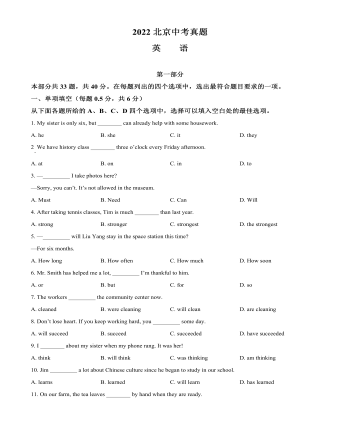
2022年北京市中考英语真题(原卷版)
When itcomes to a meaningful life, we might think of love, happiness and health. Alife filled with meaning is what most of us want for ourselves. Then, whatmakes a meaningful life?Manyresearchers agree that a meaningful life comes down to three factors (因素): havinglong-term goals, believing that one’s life matters, and feeling that one’s lifefits together and “makes sense”.But we believe there is more to consider. Sometimeslife enables us to experience small moments of beauty. When people are open toappreciating (欣赏) suchexperiences, these moments may improve how they see their own life. We callthis experiential appreciation (EA).
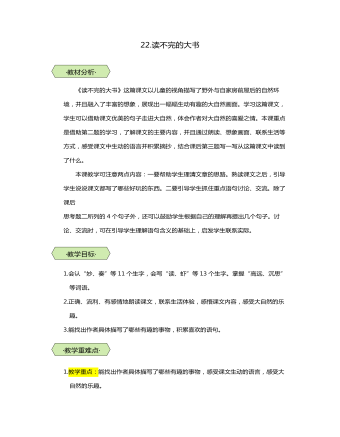
统编版三年级语文上第22课读不完的大书教学设计教案
《读不完的大书》这篇课文以儿童的视角描写了野外与自家房前屋后的自然环境,并且融入了丰富的想象,展现出一幅幅生动有趣的大自然画面。学习这篇课文,学生可以借助课文优美的句子走进大自然,体会作者对大自然的喜爱之情。本课重点是借助第二题的学习,了解课文的主要内容,并且通过朗读、想象画面、联系生活等方式,感受课文中生动的语言并积累摘抄,结合课后第三题写一写从这篇课文中读到了什么。本课教学可注意两点内容:一要帮助学生理清文章的思路。熟读课文之后,引导学生说说课文都写了哪些好玩的东西。二要引导学生抓住重点语句讨论、交流。除了课后思考题二所列的4个句子外,还可以鼓励学生根据自己的理解再提出几个句子。讨论、交流时,可在引导学生理解语句含义的基础上,启发学生联系实际。 1.会认“妙、奏”等11个生字,会写“读、虾”等13个生字。掌握“高远、沉思”等词语。2.正确、流利、有感情地朗读课文,联系生活体验,感悟课文内容,感受大自然的乐趣。3.能找出作者具体描写了哪些有趣的事物,积累喜欢的语句。 1.教学重点:能找出作者具体描写了哪些有趣的事物,感受课文生动的语言,感受大自然的乐趣。2.教学难点:能简单地写出自己感受到的大自然的乐趣,并和同学交流。 2课时

统编版三年级语文上第21课大自然的声音教学设计教案
《大自然的声音》是部编版语文三年级上册第七单元的第一篇课文。这篇课文以清新活泼的笔调介绍了大自然中风的声音、水的声音和动物的声音,课文用生动的语言,把人们习以为常的声音写得非常鲜活,妙趣横生,体现了大自然的美丽。通过这篇课文的学习,学生可以借助课文优美的句子走进大自然,体会作者对大自然的热爱之情。本单元的人文主题是感受大自然的馈赠,语文要素之一是“感受课文生动的语言,积累喜欢的语句”。本文是一篇浅显易懂、优美生动的散文。这篇文章应以读为本,阅读是学生个性化的行为,要珍视学生独特的感受和理解。要引导学生在读中感悟,在读中激情,在读中体验、品味。 1.会认“妙、奏”等9个生字,会写“演、琴”等13个生字,掌握课文相关词语。2.正确、流利课文,感知课文内容,背诵课文第2~3自然段。3.能找到第2~4自然段的关键句,了解课文写了大自然的哪些声音,感受大自然的美。4.能联系生活经验,体会课文中描写声音的词语的生动,仿照课文,围绕一种听到过的声音写几句话。 1.教学重点:能找到第2~4自然段的关键句,了解课文写了大自然的哪些声音,感受大自然的美。2.教学难点:能联系生活经验,体会课文中描写声音的词语的生动,仿照课文,围绕一种听到过的声音写几句话。 2课时